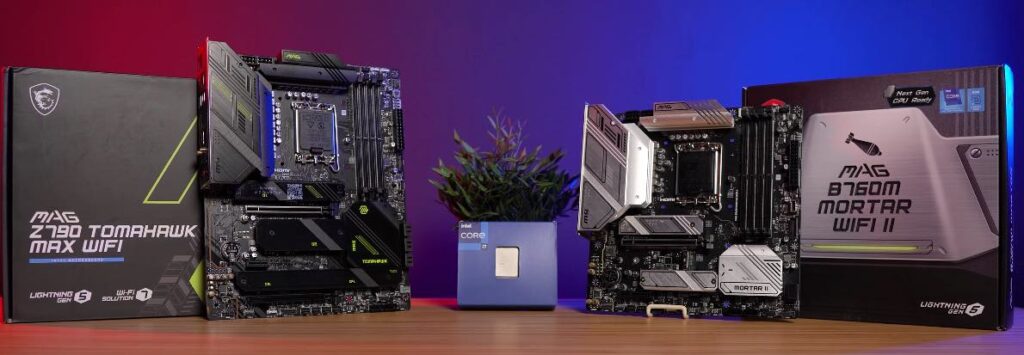Hey, what’s up, guys? 14th-generation Intel CPUs are now here. There are several models out there and chipsets as well. We’ll be focusing now on the differences between the C790 and the B760 chipset motherboards featuring MSI Mag C79 Tomahawk Max Wi-Fi and their Mag B760 M Mortar Wi-Fi. Two features are available on both motherboards, and there is a bit of testing between the two.
I am setting up two test benches with similar significant differences in performance, where the motherboards are the main factor. Let’s talk about our processor or CPU, the new Intel Core i7 14700 K. This one has 20 overall cores, eight of which are P or performance cores and 12 E or efficiency cores. Unlock the chip overclocked for gaming purposes. It is more than enough and very powerful. Then, my max turbo frequency for rendering workloads is up to 5.6 GHz, and my base power is around 125.
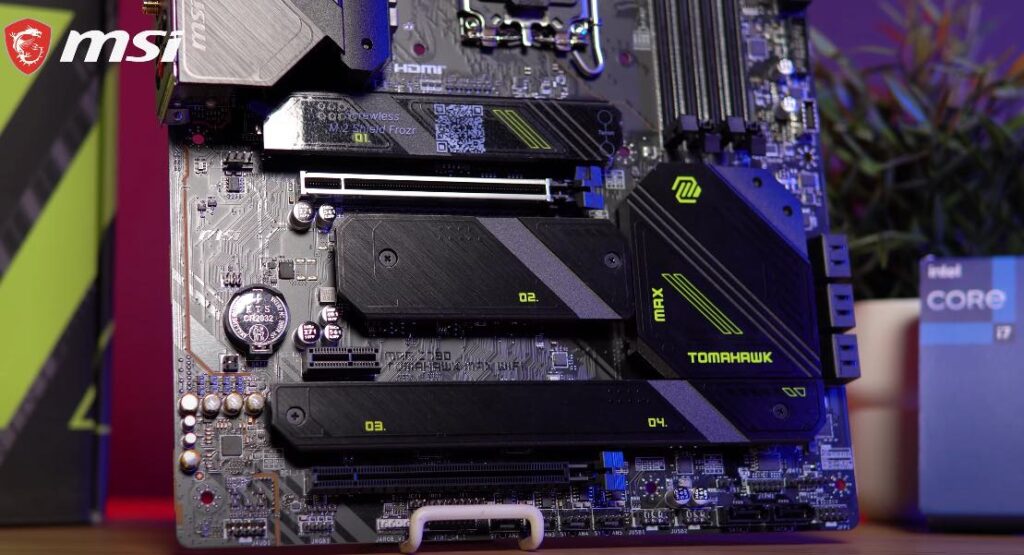
Now, let’s talk about the motherboards. First is your MSI Mag C790 Tomahawk Max Wi-Fi, equipped with a C790 chipset. It is the higher-end motherboard between the two that we’re using. It supports both 14, 13, and even 12-gen Intel Desktop CPUs, DDR5 memory, and PCIe Gen 5 devices on both the PCI slot and the M.2 slots.
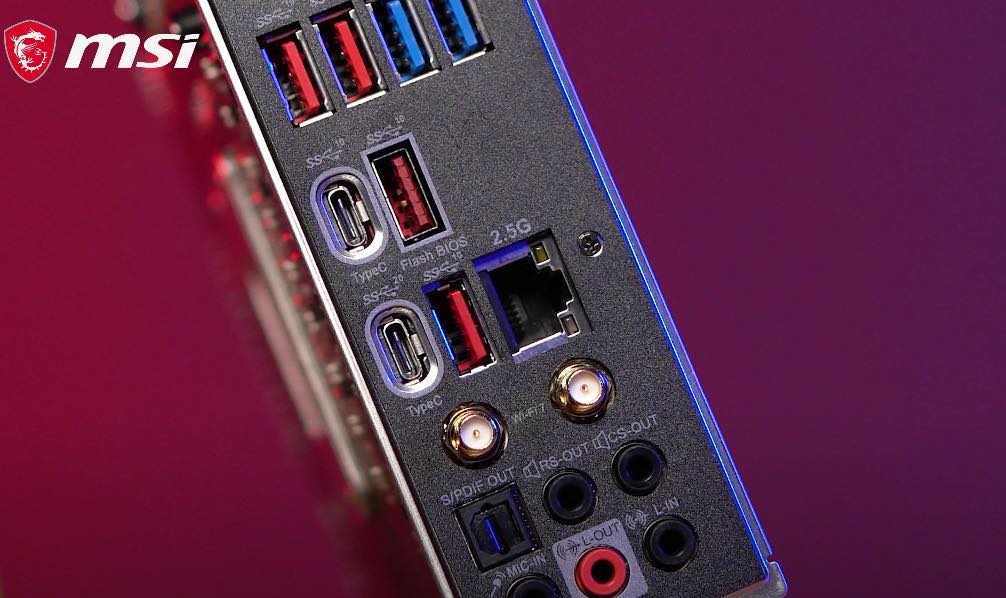
It also supports the new Wi-Fi 7 standard out of the box. It also has a 16+1+1 mirrored power arrangement or power stages. It can easily accommodate higher-end CPUs like the Core i9 and additional features or gimmicks you will not see on the lower-end models: M. 2 Shield, dual sink, and fewer M.2 slots.

On the other hand, we also have the MSI Mag B760 M Mortar Wi-Fi 2. Almost the same, it has support for 12 to 14-gen Intel CPUs and DDR5 memory, but only PCIe slot Gen 5 support. So, Gen 4 only has storage. There are also the lesser power phases at 12+1+1, with a real power system compared to 16+1+1 that you’ll find on the Z790. Also, only Wi-Fi 6E support compared to the Wi-Fi 7 on the Mag C790.

Other features such as USB 3.2 Gen 2×2, 20 Gb/s, 2.5 GB LAN, premium thermal solution with extended heat sinks, and M.2 Shield frozer, SMT, or surface mount technology of PCI slots, six-layer PCB made by two-ounce thickened copper, and server-grade level material common on both motherboards.
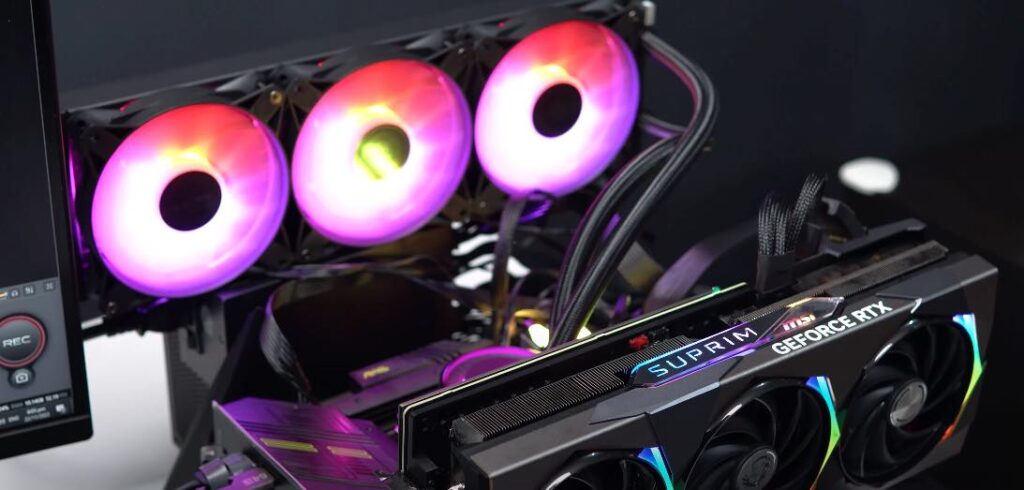
Now that we know the features and differences between the two motherboards let’s introduce the other differentiating components we’ll feature here. So, CPU Cooler, we also have two here, which is the MSI Meg Core Liquid E360 liquid cooler. We’ll test the thermals and look at the difference using those two AIOs with the Intel Core i7 14700 K.
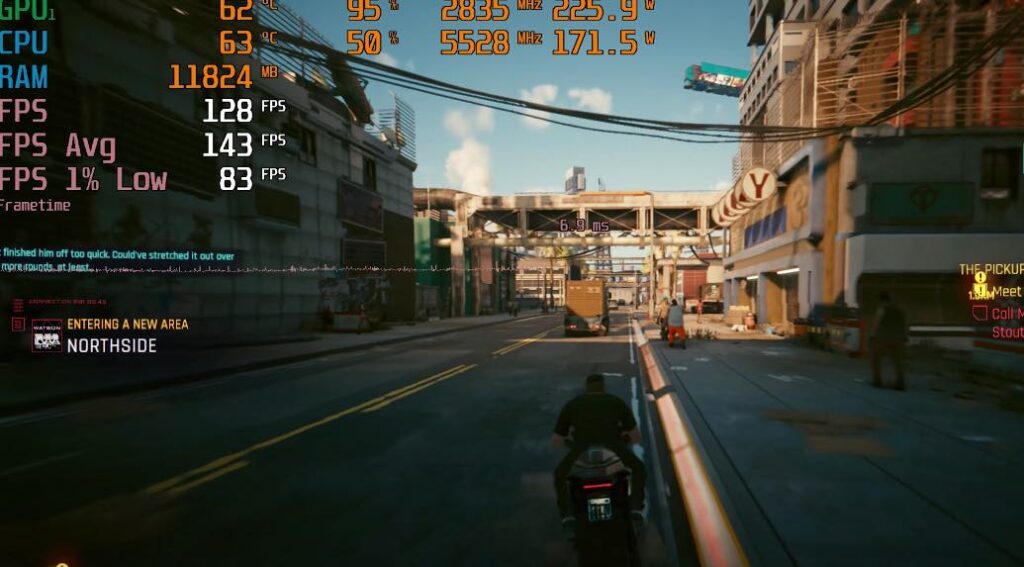
For this testing, we’ve tested some modern game titles at 1080p max settings, as well as some synthetic CPU benchmarks, performance CPU, and significant differences between the two motherboards, which have the same CPU, both non-overclocked and overclocked C790, to see how much we can gain by manually overclocking the CPU. Safe, this can still be pushed depending on the head available, and it is worth it compared to just getting a non-overclockable motherboard like the B760 and a locked CPU.
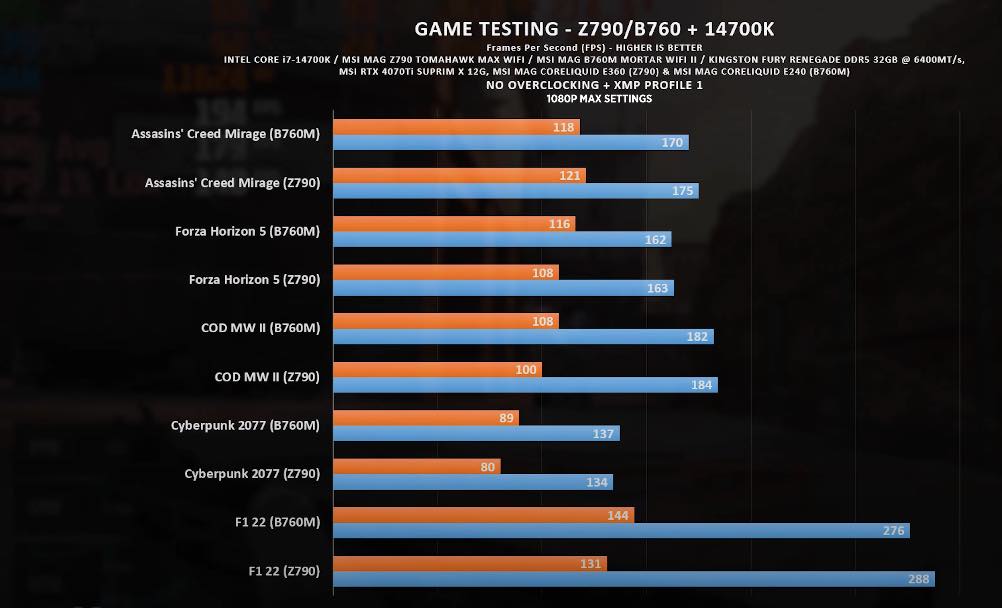
As you can see in games, there’s not much of a difference between the two motherboards, with F122 getting the most at only around 10 to 15 FPS difference, which is expected in this case, and for the others, around 1 to 5% difference in FPS, both average and 1% lows. However, it could be due to variables like thermal since we also use two different AIOs, 360 mm and 240 mm. But again, in gaming, the CPU seems okay. At least we have an idea then about the coolers’ performance.

On the synthetics, however, the story becomes different. Other than the 3D Mark Time Spy CPU Benchmark, B7 Bench, compared to the C790, we can see that Cinebench R23 scores and V-Ray are much lower. First, we’ve been thermally throttled on the 240 mm AIO, but that could be higher on par with the C790 if we also use the 360 mm cooler on the single-core benchmark.
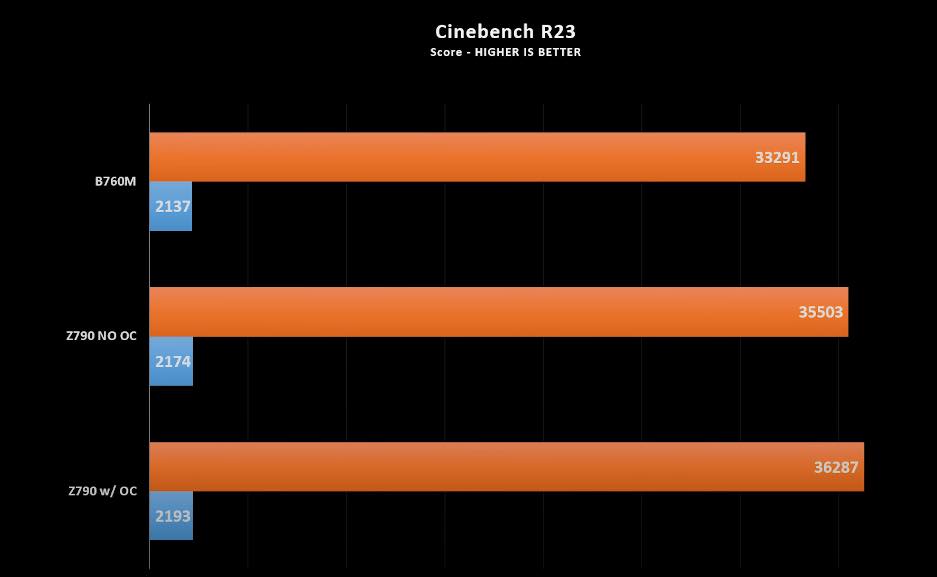
Cinebench Throttle, and they’re similar in terms of score, with the C780 hitting 3553 with a maximum of only 88°C during the test run, and the B760 plus 240 mm AIO, 101°C max temperature, thermal throttle, and the reduced score.
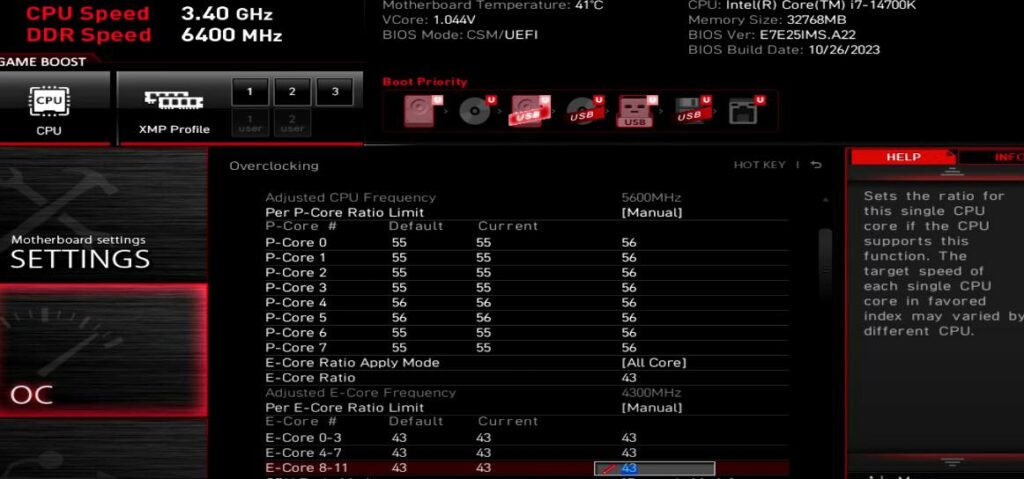
So, as for the C790 with a simple manual overclock CPU, just so my idea, I set all the P cores to 5.6 GHz and all the E cores to around 4.3 GHz. As I said, I think to push even up to 6 GHz, as long as there is thermal headroom, the CPU can still be adequately cooled.
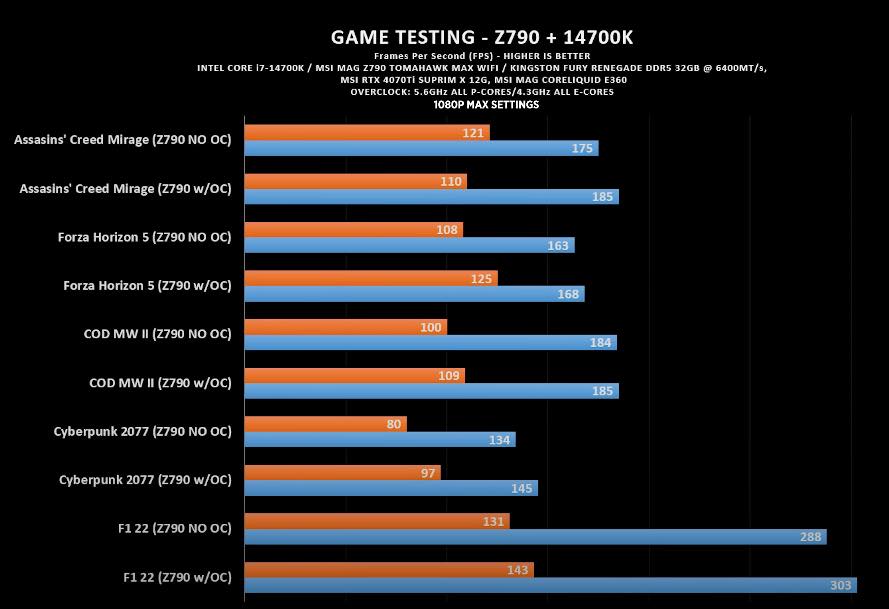
As you can see, that simple overclock can add 5 to 20% FPS in games, but at the expense of hotter CPU temps and power consumption. With that information in mind, it just boils down to what you need or want in your system. Higher-end CPUs like the Intel Core i7 14700 K or even the Core i9 overclock, whether manual or automatic overclocking, PCIe Gen 5 and NVMe SSD, or do you want the Wi-Fi 7 capability and, of course, budget? Then the answer is clear: get the C790 motherboard since it supports all the features mentioned, and it’s probably better for long-term use because it has newer standards.

If you’re using CPUs that don’t really require that much power, like the Core i5 or below, or even some i7s and be overclock totally, or you’ll be satisfied with having just a PCIe Gen 4 and NVMe storage instead of Gen 5 and Wi-Fi 6E instead of Wi-Fi 7. It’s okay to get the B760 motherboard instead, as it is much more budget-friendly, as we all saw earlier benchmarks. Unless overclocked, the two motherboard chipsets have little difference in performance.

When we overclock the CPU, we’ll have to look at the features as well as if it is worth it by you, additional markup on getting a K series Intel CPU or unlock chip and a C790 motherboard, or stick to a non-overclockable chip and B760 instead. For the cooling aspect, since we’ve also used two different AIOs for this test, the Mag Core Liquid E240
And the E360, it’s safe to say, okay, use the 240 mm on the Core i7 14700 K, but only for gaming and without overclocking; as I said earlier, synthetic loads or any other similar workload wasted or potential CPU.
So, I’d recommend picking the E360 cooler instead. So, action question. Okay, unlock the CPU like the 14700 K and pair it with a B760 motherboard. Yes, okay. The unlocked CPUs have a higher base clock and boost clock frequencies by default than their non-K variants. So, overclock due to being limited by the motherboard choice. Okay, you’ll pay a little higher for the additional performance.
